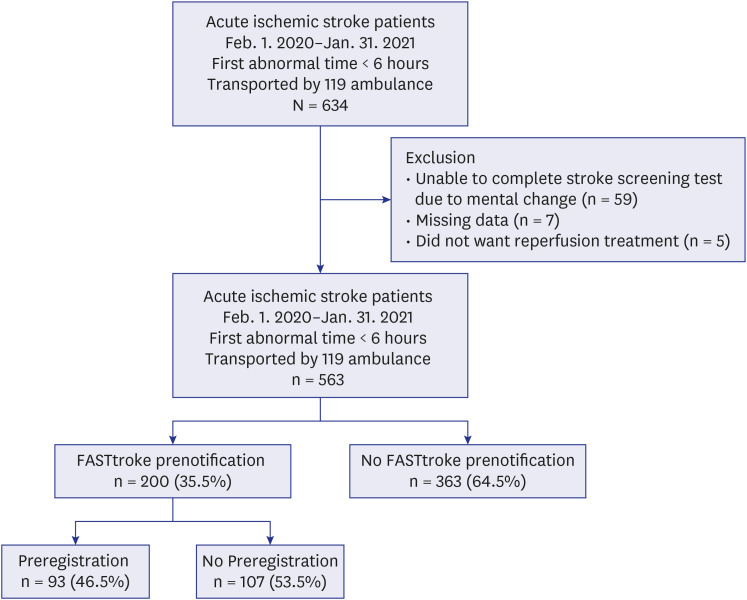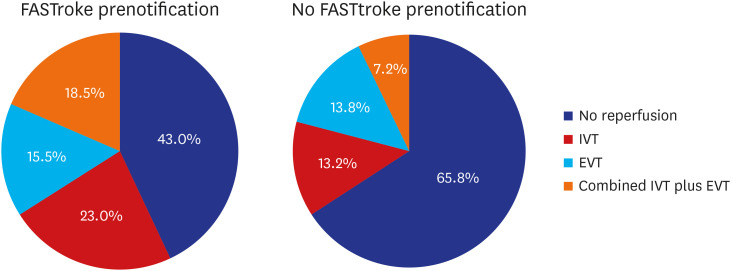J Korean Med Sci.
2021 Dec;36(48):e327. 10.3346/jkms.2021.36.e327.
Prehospital Notification Using a Mobile Application Can Improve Regional Stroke Care System in a Metropolitan Area
- Affiliations
-
- 1Department of Emergency Medicine, Keimyung University Dongsan Hospital, Keimyung University School of Medicine, Daegu, Korea
- 2Department of Emergency Medicine, School of Medicine, Kyungpook National University, Daegu, Korea
- 3Department of Neurology, Keimyung University Dongsan Hospital, Keimyung University School of Medicine, Daegu, Korea
- 4Department of Neurology, Kyungpook National University Hospital, School of Medicine, Kyungpook National University, Daegu, Korea
- 5Department of Neurology, Catholic University of Daegu School of Medicine, Daegu, Korea
- 6Department of Neurosurgery, Daegu Fatima Hospital, Daegu, Korea
- 7Department of Emergency Medicine, Yeungnam University College of Medicine, Daegu, Korea
- KMID: 2523305
- DOI: http://doi.org/10.3346/jkms.2021.36.e327
Abstract
- Background
Acute ischemic stroke is a time-sensitive disease. Emergency medical service (EMS) prehospital notification of potential patients with stroke could play an important role in improving the in-hospital medical response and timely treatment of patients with acute ischemic stroke. We analyzed the effects of FASTroke, a mobile app that EMS can use to notify hospitals of patients with suspected acute ischemic stroke at the prehospital stage.
Methods
We conducted a retrospective observational study of patients diagnosed with acute ischemic stroke at 5 major hospitals in metropolitan Daegu City, Korea, from February 2020 to January 2021. The clinical conditions and time required for managing patients were compared according to whether the EMS employed FASTroke app and further compared the factors by dividing the patients into subgroups according to the preregistration received by the hospitals when using FASTroke app.
Results
Of the 563 patients diagnosed with acute ischemic stroke, FASTroke was activated for 200; of these, 93 were preregistered. The FASTroke prenotification showed faster door-tocomputed-tomography times (19 minutes vs. 25 minutes, P < 0.001), faster door-to-intravenousthrombolysis times (37 minutes vs. 48 minutes, P < 0.001), and faster door-to-endovascularthrombectomy times (82 minutes vs. 119 minutes, P < 0.001). The time was further shortened when the preregistration was conducted simultaneously by the receiving hospital.
Conclusion
The FASTroke app is an easy and useful tool for prenotification as a regional stroke care system in the metropolitan area, leading to reduced transport and acute ischemic stroke management time and more reperfusion treatment. The effect was more significant when the preregistration was performed jointly.
Figure
Reference
-
1. Warner JJ, Harrington RA, Sacco RL, Elkind MS. Guidelines for the early management of patients with acute ischemic stroke: 2019 update to the 2018 guidelines for the early management of acute ischemic stroke. Stroke. 2019; 50(12):3331–3332. PMID: 31662117.
Article2. Saver JL, Goyal M, van der Lugt A, Menon BK, Majoie CB, Dippel DW, et al. Time to treatment with endovascular thrombectomy and outcomes from ischemic stroke: a meta-analysis. JAMA. 2016; 316(12):1279–1288. PMID: 27673305.
Article3. Saver JL, Fonarow GC, Smith EE, Reeves MJ, Grau-Sepulveda MV, Pan W, et al. Time to treatment with intravenous tissue plasminogen activator and outcome from acute ischemic stroke. JAMA. 2013; 309(23):2480–2488. PMID: 23780461.
Article4. Messé SR, Khatri P, Reeves MJ, Smith EE, Saver JL, Bhatt DL, et al. Why are acute ischemic stroke patients not receiving IV tPA? Results from a national registry. Neurology. 2016; 87(15):1565–1574. PMID: 27629092.5. Powers WJ, Rabinstein AA, Ackerson T, Adeoye OM, Bambakidis NC, Becker K, et al. 2018 guidelines for the early management of patients with acute ischemic stroke: a guideline for healthcare professionals from the American Heart Association/American Stroke Association. Stroke. 2018; 49(3):e46–110. PMID: 29367334.
Article6. Lin CB, Peterson ED, Smith EE, Saver JL, Liang L, Xian Y, et al. Emergency medical service hospital prenotification is associated with improved evaluation and treatment of acute ischemic stroke. Circ Cardiovasc Qual Outcomes. 2012; 5(4):514–522. PMID: 22787065.
Article7. Fassbender K, Balucani C, Walter S, Levine SR, Haass A, Grotta J. Streamlining of prehospital stroke management: the golden hour. Lancet Neurol. 2013; 12(6):585–596. PMID: 23684084.
Article8. Kothari RU, Pancioli A, Liu T, Brott T, Broderick J. Cincinnati prehospital stroke scale: reproducibility and validity. Ann Emerg Med. 1999; 33(4):373–378. PMID: 10092713.
Article9. Kogan E, Twyman K, Heap J, Milentijevic D, Lin JH, Alberts M. Assessing stroke severity using electronic health record data: a machine learning approach. BMC Med Inform Decis Mak. 2020; 20(1):8. PMID: 31914991.
Article11. Meretoja A, Strbian D, Mustanoja S, Tatlisumak T, Lindsberg PJ, Kaste M. Reducing in-hospital delay to 20 minutes in stroke thrombolysis. Neurology. 2012; 79(4):306–313. PMID: 22622858.
Article12. Meretoja A, Weir L, Ugalde M, Yassi N, Yan B, Hand P, et al. Helsinki model cut stroke thrombolysis delays to 25 minutes in Melbourne in only 4 months. Neurology. 2013; 81(12):1071–1076. PMID: 23946303.
Article13. McKinney JS, Mylavarapu K, Lane J, Roberts V, Ohman-Strickland P, Merlin MA. Hospital prenotification of stroke patients by emergency medical services improves stroke time targets. J Stroke Cerebrovasc Dis. 2013; 22(2):113–118. PMID: 21820919.
Article14. Patel MD, Rose KM, O'Brien EC, Rosamond WD. Prehospital notification by emergency medical services reduces delays in stroke evaluation: findings from the North Carolina stroke care collaborative. Stroke. 2011; 42(8):2263–2268. PMID: 21659638.15. Shkirkova K, Akam EY, Huang J, Sheth SA, Nour M, Liang CW, et al. Feasibility and utility of an integrated medical imaging and informatics smartphone system for management of acute stroke. Int J Stroke. 2017; 12(9):953–960. PMID: 28358291.
Article16. Noone ML, Moideen F, Krishna RB, Pradeep Kumar VG, Karadan U, Chellenton J, et al. Mobile app based strategy improves door-to-needle time in the treatment of acute ischemic stroke. J Stroke Cerebrovasc Dis. 2020; 29(12):105319. PMID: 32992177.
Article17. Martins SC, Weiss G, Almeida AG, Brondani R, Carbonera LA, de Souza AC, et al. Validation of a smartphone application in the evaluation and treatment of acute stroke in a comprehensive stroke center. Stroke. 2020; 51(1):240–246. PMID: 31847753.
Article18. Dickson RL, Sumathipala D, Reeves J. Stop stroke(c) acute care coordination medical application: a brief report on postimplementation performance at a primary stroke center. J Stroke Cerebrovasc Dis. 2016; 25(5):1275–1279. PMID: 26971040.19. Tan BY, Ngiam NJ, Sunny S, Kong WY, Tam H, Sim TB, et al. Improvement in door-to-needle time in patients with acute ischemic stroke via a simple stroke activation protocol. J Stroke Cerebrovasc Dis. 2018; 27(6):1539–1545. PMID: 29422380.
Article20. De Luca A, Mariani M, Riccardi MT, Damiani G. The role of the Cincinnati Prehospital Stroke Scale in the emergency department: evidence from a systematic review and meta-analysis. Open Access Emerg Med. 2019; 11:147–159. PMID: 31410071.21. Carr BG, Matthew Edwards J, Martinez R. 2010 Academic Emergency Medicine consensus conference, Beyond Regionalization: Integrated Networks of Care. Regionalized care for time-critical conditions: lessons learned from existing networks. Acad Emerg Med. 2010; 17(12):1354–1358. PMID: 21122020.
Article22. Sirimarco G, Lavallée PC, Labreuche J, Meseguer E, Cabrejo L, Guidoux C, et al. Overlap of diseases underlying ischemic stroke: the ASCOD phenotyping. Stroke. 2013; 44(9):2427–2433. PMID: 23860300.23. Fonarow GC, Saver JL, Smith EE, Broderick JP, Kleindorfer DO, Sacco RL, et al. Relationship of national institutes of health stroke scale to 30-day mortality in medicare beneficiaries with acute ischemic stroke. J Am Heart Assoc. 2012; 1(1):42–50. PMID: 23130117.
Article
- Full Text Links
- Actions
-
Cited
- CITED
-
- Close
- Share
- Similar articles
-
- Prehospital Notification from the Emergency Medical Service Reduces the Transfer and Intra-Hospital Processing Times for Acute Stroke Patients
- Facilitating Stroke Management using Modern Information Technology
- Prehospital Trauma Care System in Seoul by 119 Rescue Services
- Implementation of a Prehospital ALS (Advanced Life Support) Program in the Seoul Metropolitan Area
- Prehospital Delay Factors After Stroke and Paramedic Identification of Stroke Patients in a Metropolitan City Emergency Medical Service System



